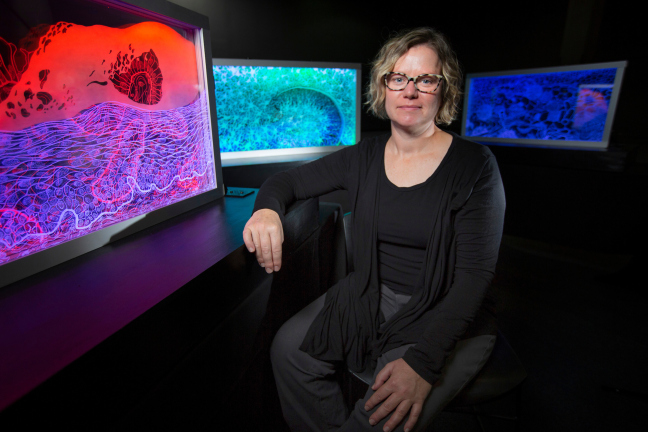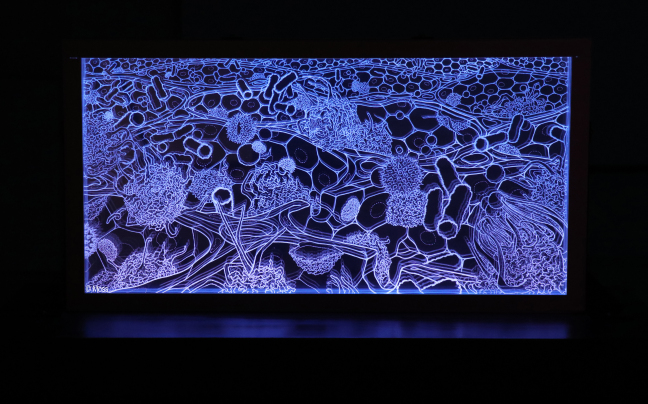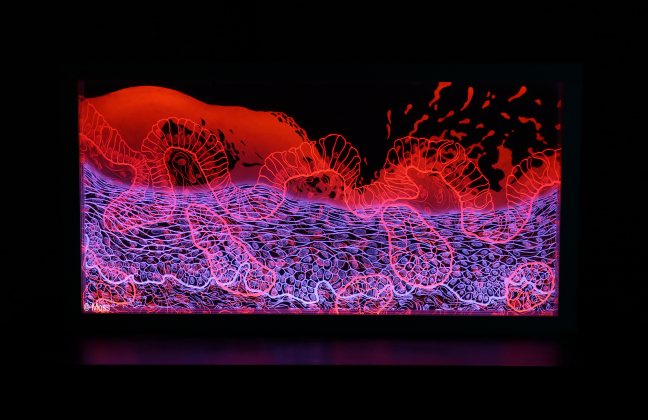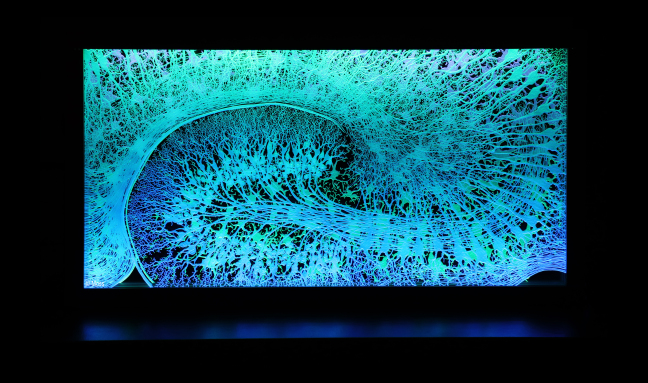
Kim Moss, assistant professor of art and visual culture and coordinator of Iowa State's biological and premedical illustration program, has created three LED-lit hand-etched glass panels, each showing microscopic processes in the body. Photo by Christopher Gannon. Larger image.
AMES, Iowa – Her father’s cancer diagnosis threw Kimberly Moss into a world of unknowns and anxiety.
Moss, an assistant professor of art and visual culture and coordinator of the biological and premedical illustration program at Iowa State University, has an extensive background as a medical illustrator. But she wasn’t prepared for the complexity of esophageal cancer, and the stress of the diagnosis.
It got her thinking about how people process the overwhelming amount of information about health and disease. Over three years, Moss created three glass panels, each showing diseases and systems on what she calls “supersized microscope slides.” The work was made possible through a research grant from ISU’s Center for Excellence in the Arts and Humanities.
“The Landscapes Within” gives viewers an opportunity to see the larger-than-life details of different defense mechanisms and cellular relationships in the body – and to reflect on the choices they can make to improve their health.
“Low health literacy results from the anxiety one feels from a diagnosis, procedure or simply being in a clinic. If you’re worried and stressed, it’s hard to process information, let alone complex content concerning healing and disease in the body. Stress also reduces flexible thinking and affects decision-making,” Moss said. “People get tunnel vision and it’s difficult to absorb information.”
This installation is a new way to reach people in those stressful situations, Moss says, particularly when they’re physically in a health setting such as a hospital – which can produce its own anxieties.
Moss plans for “Landscapes” to be installed in various public spaces – especially health settings – in the coming months. The panels will be the centerpiece, with explanations next to each so viewers can understand what they’re seeing. Her longer-term plan is to research viewers’ reactions to and interpretations of the piece, their reason for being there and how they receive health information.
“Viewers can consider their history and their health lifestyle choices,” she said. “They have a visual to connect with what’s happening in the body.”
Each piece is made of three panels, giving them depth as if viewing a landscape of cells. Moss used a stippling and line-drawing process to hand-etch her original drawings into the nine glass panels. The frames hold LED lights, illuminating each piece in a low-lit setting.
“It’s all about the beauty within and appreciating that our bodies respond to exercise, stress and different stimuli in positive and negative ways,” Moss said.
‘The Innate Immune Response’
“The Innate Immune Response” illuminates the body’s innate immune system in the lungs, with particular focus on defense mechanisms such as alveolar macrophages. Alveolar macrophages are the lungs’ first line of defense against harmful things we inhale, as well as abnormal cells. The piece speaks to not only their inherent function but how they work to battle the environment, such as cigarette smoke and poor air quality.

"The Innate Immune Response." Photo by Kimberly Moss. ©Kimberly Moss
‘Transitional Cells’
The second panel, “Transitional Cells,” is personal for Moss as it displays how the cells lining the esophagus respond to chronic acid reflux – essentially transitioning to start resembling cells lining the intestine, which can be a precursor to esophageal cancer. A majority of the population experiences gastric acid reflux at some point in their lives. Moss hopes this piece promotes healthy choices – such as improving diet and reducing caffeine and alcohol intake – to control acid reflux and help restore normal tissue lining.
This piece shows different positive and negative scenarios simultaneously, reflecting the fact that these cells can regenerate with corrective behaviors. The blue represents normal esophageal lining cells, the dark red shows gastric acid and the orange shows cancerous tissue.

"Transitional Cells." Photo by Kimberly Moss. ©Kimberly Moss
‘Response to Stimulus’
The final panel, “Response to Stimulus,” shows incredible detail of the hippocampus – the part of the brain connected to memory, learning and emotion.
Research has shown that chronic stress and anxiety can change neuropathways in this part of the brain and affect memory retention. Neuroscientists are starting to research whether exercise and positive affirmations can help this part of the brain in terms of adult neurogenesis: the process of generating new neurons and strengthening neural pathways.

"Response to Stimulus." Photo by Kimberly Moss. ©Kimberly Moss